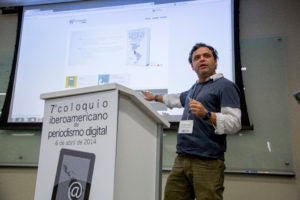April 8, 2014 | Coloquio, International
During Ibero-American Colloquium, journalists discuss revenue diversification and differentiation strategies

A group of journalists representing media from several Latin American countries presented the successes, obstacles and future plans of their organizations on April 6 at the Seventh Ibero-American Colloquium on Digital Journalism, organized by the Knight Center for Journalism in the Americas.
During the colloquium, which took place after the end of the 15th International Symposium on Online Journalism (ISOJ), participants discussed ideas and impressions from the event and talked about their experiences with their digital media.
One of the most discussed topics related to finding new sources of income and revenue strategies to help sustain news organizations. Also discussed were the importance of creating “useful and delightful” content, of considering each journalist and medium as a brand and of forming a more permanent relationship with readers.
Gabriel Pasquini talked about the Argentine website, El Puercoespín, which he directs and helped found four years ago and is currently facing an uncertain future. The online magazine – which produces long-form journalism and has a geographically-dispersed audience – suspended its operations earlier in the week while it searches for new ways of financing itself.
Pasquini said there was no one formula for sustainability that could be applied to all media, but rather that each one of them had to find their own unique solution. El Puercoespín tried to obtain a thousand subscriptions to create a membership mechanism that would provide it with revenue but was not successful. Pasquini concluded that although the model does work it requires initial capital to support an organization while it establishes more stable sources of revenue.
Brazilian journalist Natalia Viana spoke about the investigative journalism agency A Pública, a nonprofit organization. A Pública produces journalism focused on data, documents and stories that provide ample context.
Viana mentioned a crowdfunding project undertaken by the nonprofit, in which each donor had the opportunity to vote for 12 investigative projects. The project was a success and managed to raise more than $25,000, money that has already being used to finance four investigative stories.
Francisca Skoknic represented the Chilean investigation center Ciper, a nonprofit foundation that publishes stories since 2007 with support from other foundations. Although it is a small organization, the impact of their work is notable and has resulted in resignations from public officials responsible for illegal actions.
This year, the nonprofit faced an unexpected but ever-more-common threat when their website was hacked twice in little more than a month, something that highlighted the need to use funds not only to produce journalism but also to protect their portal.
“Doing journalism that makes people uncomfortable also leads to people wanting to silence you, which can make it an easy target for certain people,” Skoknic said.
Another journalistic model is used by the online news site El Faro, from El Salvador, directed by journalist Carlos Dada, who presented in the colloquium how his organization focused on creating unique content that helped differentiate its brand from other media.
El Faro, which focuses on investigatory projects about cultural and political topics, writes articles, films documentaries, publishes photo essays, produces animated videos based on stories and even has an online store for selling the content it produces. However, its primary revenue source continues to be traditional advertising along with support from foundations.
Enrique Naveda from Plaza Pública in Guatemala said his organization subsisted through sponsorship from the Universidad Rafael Landívar and international organizations like Open Society Foundations. The outlet produces investigatory stories and seeks to improve “the quality of journalists in Guatemala,” with the intention of spreading information rather than generating profit. This same organization produced Martín Rodríguez Pellecer, who seeks to launch a new web site for vanguard journalism called Nómada, which aside from doing investigatory journalism will provide data visualization and articles on social or everyday topics.
The Peruvian magazine El Búho, represented by Mabel Cáceres, has been limited since 2011 to a monthly format, rather than weekly, due to lack of funds. The organization sought to diversify by creating an online television channel and plans to convert its webpage into a digital daily, adding new content every day focused on politics and culture.
Gustavo Gorriti from IDL-Reporteros, also from Peru, spoke about his online investigatory organization, whose stories focus on topics not covered by the rest of the Peruvian press and seek to have an impact in the country’s politics. The website publishes new stories as they are finished – sometimes with weeks between issues – and, like other organizations, also receives support from Open Society Foundations.
At the end of the colloquium’s first session, Carlos Chamorro from Nicaragua spoke about his outlet, Confidencial, a website with videos that seeks to do quality journalism in the face of “a growing control and growth of official media.” Unlike other organizations, Confidencial is a for-profit organization that begun as a television program that was originally lucrative. Like many others, Confidencial seeks to do credible journalism and become more sustainable.

